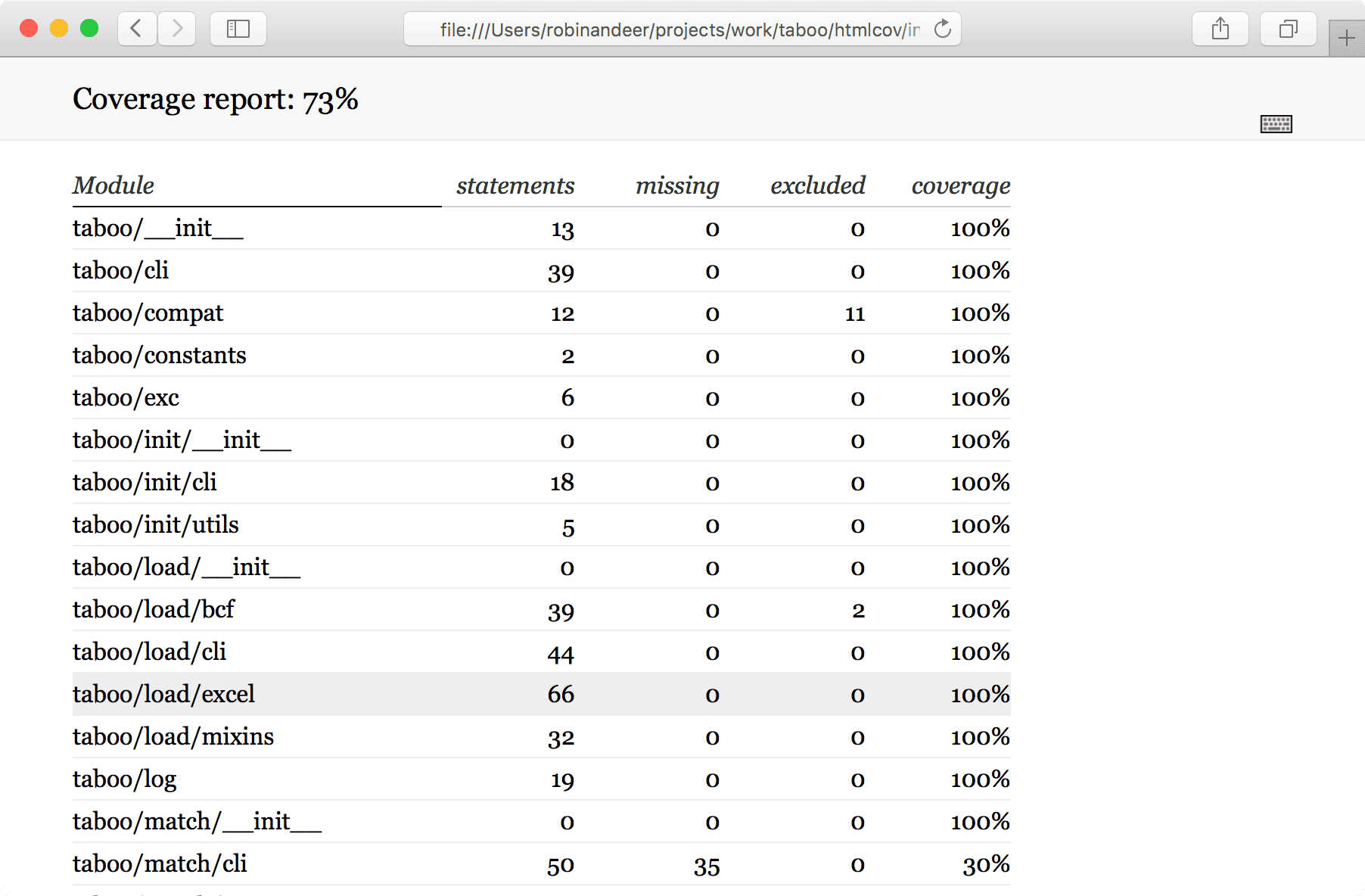How I test my code: coverage and automation (part 3)
June 22, 2016
This is the third installment in my "How I test code"-series. In this post, I get into the benefits of measuring test coverage and show how you can run automated tests; locally and remotely.
Test coverage
I'm a fan of tracking test coverage. It tells you how many lines of code are executed when you run your test suite. To be clear: 100% test coverage doesn't mean you have written a perfect test suite. However, it does indicate the level of ambition and that makes it a good starting point!
I'm using Python as an example along with the pytest test runner. Here you will use pytest-cov to measure coverage:
pip install pytest-cov
py.test --cov-report html --cov [myPackage] --verbose
open htmlcov/index.html
This will open a coverage report in your browser.

You can dig into individual modules to see exactly which lines you're missing. Reaching 100% can seem close to impossible. Sometimes it doesn't even make sense to test a certain block of code which is why you can exclude parts by adding a comment in your source:
def run_external(program_call):
try:
subprocess.check_call(program_call)
except CalledProcessError as error: # pragma: no cover
# some unexpected error; we just want to exit cleanly
abort()
The coverage report will report the block after pragma: no cover as excluded but it won't count against your overall coverage percentage.
Automation
Making the computer do work for you is always nice. Do it whenever possible! You reduce mental load and avoid human error.
In automation we trust, or something like that 😉
Automating local testing
You can setup pytest to run your suite every time you make changes to your code. This is especially nice when combined with tracking test coverage. As soon as you add a test, the test suite will be rerun and the coverage score updated! This creates a feedback loop to push you to write more tests!
With pytest, all you need is another plugin:
pip install pytest-xdist
py.test --cov-report html --cov [myPackage] --verbose --looponfail
pytest will now watch your project files for changes. If some tests fail, only they will be rerun until they are successfully fixed.
Automating remote testing
There's another layer to test automation. Continuous integration (CI) is already an industry standard and running your tests automatically on a remote server makes a lot of sense:
- results are picked up automatically by sites like GitHub
- you need to think about how to install on cloud infrastructure
- the code must run somewhere other than your development machine
The CI service of choice for open source projects is Travis. It's free and basically only requires a .travis.yml file in your repo and the flip of a switch to get started. Travis already has general guidelines on setting up a Python project. Here I will stick to sharing some tips and tricks I've come across.
These are some common feature of my .travis.yml files:
[...]
notifications:
email: never
[...]
script:
- coverage run --source [myPackage] setup.py test
after_success:
coveralls
GitHub badges are more than a gimmick. A green Travis badge inspires confidence in your project - your "master" branch is working! Likewise you can back up that claim by showcasing you test coverage. Coveralls.io provides this exact service and integrates nicely with GitHub/Travis.
Unfortunately I've had some issues getting pytest-cov to work with Coveralls. The fix I've found is to use test integration in setup.py. Add this block of code to use pytest when running python setup.py test:
# setup.py
from setuptools.command.test import test as TestCommand
class PyTest(TestCommand):
"""Setup the py.test test runner."""
def finalize_options(self):
"""Set options for the command line."""
TestCommand.finalize_options(self)
self.test_args = []
self.test_suite = True
def run_tests(self):
"""Execute the test runner command."""
# Import here, because outside the required eggs aren't loaded yet
import pytest
sys.exit(pytest.main(self.test_args))
BONUS: Linting
Synchronizing and harmonizing code style across a project is a big benefit when on-boarding new contributors. Letting it be up to an objective script to tell you and your collaborators when something breaks a style guide is much easier to take than from your peers :wink:
Along with detecting syntax deviation, tools like pylint can help you detect errors in your code before it's pushed to a public repository. I recommend integrating it directly with your editor so you get feedback as early as possible. In Sublime Text you only need one package to get everything setup: Anaconda.
Conclusion
That concludes "How I test my code" - I hope you enjoyed the series 🙂. I might return to it in the future to cover additional topics like mocking and functional/integration tests. If you have another topic in mind or feedback on the posts so far, feel free to reach out on @robinandeer on Twitter.